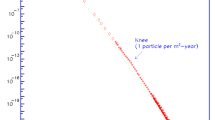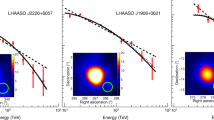Abstract
A general formula is derived for calculating the γ-ray spectrum resulting from the annihilation of cosmic-ray positrons. This formula is used to calculate annihilation-γ-ray spectra from various equilibrium spectra of secondary galactic positrons. These spectra are then compared with the γ-ray spectra produced by other astrophysical processes.
Particular attention is paid to the form of the γ-ray spectrum resulting from the annihilation of positrons having kinetic energies below 5 keV. It is found that for mean leakage times out of the galaxy of less than 400 million years, most of the positrons annihilating near rest come from the β-decay of unstable nuclei produced in cosmic-ray p-C12, p-N14, and p-O16 interactions, rather than from pi-meson decay. It is further found that the large majority of these positrons will annihilate from an S state of positronium and that 3/4 of these will produce a three-photon annihilation continuum rather than the two-photon line spectrum at 0.51 MeV. The results of numerical calculations of the γ-ray fluxes from these processes are given. It is concluded that annihilation γ-rays from the galactic halo may remain forever masked by a metagalactic continuum. However, an 0.51 MeV line from the disk may well be detectable. It is most reasonable to assume that this line is formed predominantly by the annihilation of the CNO β-decay positrons. Under this assumption, the intensity of the line becomes a sensitive measure of the galactic cosmic-ray flux below 1000 MeV/nucleon.
Similar content being viewed by others
References
Allen, C. W.: 1963,Astrophysical Quantities, 2nd ed., Athlone Press, Univ. of London, London.
Anand, S.P.S., Daniel, andStephens: 1968. Preprint.
Audouze, J., Epherre, M., andReeves, H.: 1967, ‘Survey of Experimental Cross Sections for Photon Induced Spallation Reactions in He4, C12, N14 and O16’, inHigh Energy Nuclear Interactions in Astrophysics (ed. by B.S.P. Shen), Benjamin, New York.
Berger, M. J. andSeltzer, S. M.: 1964, NASA Special Report SP-3012.
Cheshire, I. M.: 1964,Proc. Phys. Soc. 83, 227.
Comstock, G. M., Fan, C. Y., andSimpson, J. A.: 1966,Astrophys. J. 146, 51.
Deutsch, M.: 1953, ‘Annihilation of Positrons’, inProgress in Nuclear Physics, Vol. 3 (ed. by O. Frisch), Pergamon Press, London, pp. 131–158.
Dirac, P. A. M.: 1930,Proc. Camb. Phil. Soc. 26, 361.
Dovzhenko, O. I. andPomanskii, A. A.: 1964,Sov. Phys. JETP 18, 187.
Fazio, G. G., Stecker, F. W., andWright, J. P.: 1966,Astrophys. J. 144, 611.
Felten, J. E.: 1965,Phys. Rev. Letters 15, 1003.
Felten, J. E., andMorrison, P.: 1966,Astrophys. J. 146, 686.
Ginzburg, V. L. andSyrovatski, S. I.: 1964a,Sov. Phys. JETP,18, 245.
Ginzburg, V. L. andSyrovatski, S. I.: 1964b,The Origin of Cosmic Rays, Macmillan, New York.
Ginzburg, V. L. andSyrovatski, S. I.: 1964c,Usp. Fiz. Nauk 84, 201; translation:Sov. Phys. Uspekhi 7 (1965) 696.
Gould, R. J.: 1965,Phys. Rev. Letters 15, 511.
Gould, R. J.: 1967,Amer. J. Phys. 35, 376.
Gould, R. J. andBurbidge, G. R.: 1963,Astrophys. J. 138, 969.
Hartman, R. C.: 1967,Astrophys. J. 150, 371.
Hayakawa, S. andKitao, K.: 1956,Prog. Theor. Phys. 16, 139.
Hayakawa, S., Okuda, H., Tanaka, Y., andYamamoto, Y.: 1964,Prog. Theor. Phys. Suppl. (Japan) 30, 153–203.
Heitler, W.: 1960,The Quantum Theory of Radiation, Oxford University Press, London.
Hoyle, F.: 1965,Phys. Rev. Letters 15, 131.
Jones, F. C.: 1963,J. Geophys. Res. 68, 4399.
Metzger, A. E., Anderson, E. C., Van Dilla, M. A., andArnold, J. R.: 1964,Nature,204, 766.
Morrison, P.: 1961, inHandbuch der Physik 46-1, Springer, Berlin.
Ore, A. andPowell, J. L.: 1949,Phys. Rev. 75, 1696.
Pollack, J. B. andFazio, G. G.: 1963,Phys. Rev. 313, 2684.
Ramaty, R. andLingenfelter, R. E.: 1966a,J. Geophys. Res. 71, 3687.
Ramaty, R. andLingenfelter, R. E.: 1966b,Phys. Rev. Letters 17, 1230.
Shen, C. S.: 1967,Phys. Rev. Letters 19, 399.
Shen, C. S. andBerkey, G.: 1968,Astrophys. J. 151, 895.
Silk, J.: 1968,Astrophys. J. Letters 151, L19.
Stecker, F. W.: 1967a, Smithsonian Astrophys. Obs. Spec. Rpt. No. 260.
Stecker, F. W.: 1967b, Smithsonian Astrophys. Obs. Spec. Rpt. No. 262.
Stokes, G. A., Partridge, R. B., andWilkinson, D. T.: 1967,Phys. Rev. Letters,19, 1199.
Author information
Authors and Affiliations
Rights and permissions
About this article
Cite this article
Stecker, F.W. Equilibrium spectra of secondary cosmic-ray positrons in the galaxy and the spectrum of cosmic gamma-rays resulting from their annihilation. Astrophys Space Sci 3, 579–599 (1969). https://doi.org/10.1007/BF00704862
Received:
Issue Date:
DOI: https://doi.org/10.1007/BF00704862




